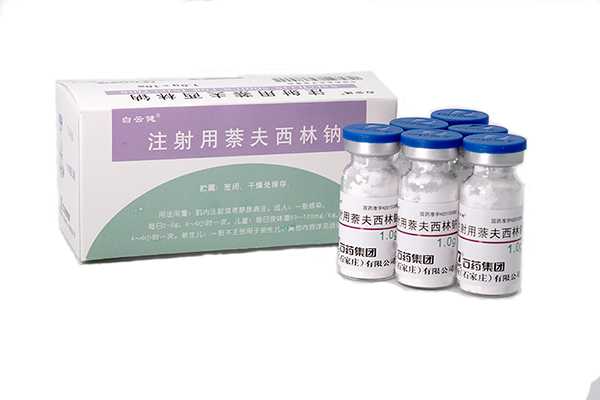Nafcillin Sodium
NAFCILLIN SODIUM- nafcillin sodium injection, powder, for solution
(Store below 30°C (86°F), protected from light.)
For Intravenous Injection Only
To reduce the development of drug-resistant bacteria and maintain the
effectiveness of nafcillin for injection and other antibacterial drugs,
nafcillin for injection should be used only to treat or prevent
infections that are proven or strongly suspected to be caused by
bacteria.
DESCRIPTION
Nafcillin for injection is a sterile semisynthetic penicillin derived
from the penicillin nucleus 6-aminopenicillanic acid. The chemical name
of nafcillin sodium is Monosodium (2S,5R,6R)-6-(2-ethoxy-
1-naphthamido)-3,3
dimethyl-7-oxo-4-thia-1-azabicyclo[3.2.0]heptane-2-carboxylate
monohydrate. It is resistant to inactivation by the enzyme penicillinase
(beta-lactamase).
Nafcillin for injection intended for intravenous administration only,
contain nafcillin sodium as a sterile white to slightly yellowish powder
for reconstitution. The pH of the reconstituted solution is 6 to 8.5.
Nafcillin for injection contains nafcillin sodium as the monohydrate
equivalent to 1 gram of nafcillin per vial and is buffered with
approximately 40 mg sodium citrate per gram of nafcillin. The sodium
content is 66.1 mg [2.9 mEq] for the 1 g vial.
INDICATIONS AND USAGE
Nafcillin is indicated in the treatment of infections caused by penicillinase-producing staphylococci which
have demonstrated susceptibility to the drug. Culture and
susceptibility tests should be performed initially to determine the
causative organism and its susceptibility to the drug.
Nafcillin should not be used in infections caused by organisms
susceptible to penicillin G. If the susceptibility tests indicate that
the infection is due to methicillin-resistant Staphylococcus sp., therapy with nafcillin for injection should be discontinued and alternative therapy provided.
To reduce the development of drug-resistant bacteria and maintain the
effectiveness of nafcillin for injection and other antibacterial drugs,
nafcillin for injection should be used only to treat or prevent
infections that are proven or strongly suspected to be caused by
susceptible bacteria. When culture and susceptibility information are
available, they should be considered in selecting or modifying
antibacterial therapy. In the absence of such data, local epidemiology
and susceptibility patterns may contribute to the empiric selection of
therapy.
Information for Patients
Patients should be counseled that antibacterial drugs including
nafcillin for injection should only be used to treat bacterial
infections. They do not treat viral infections (e.g., the common cold).
When nafcillin for injection is prescribed to treat a bacterial
infection, patients should be told that although it is common to feel
better early in the course of therapy, the medication should be taken
exactly as directed. Skipping doses or not completing the full course of
therapy may (1) decrease the effectiveness of the immediate treatment
and (2) increase the likelihood that bacteria will develop resistance
and will not be treatable by Nafcillin for Injection or other
antibacterial drugs in the future.
Diarrhea is a common problem caused by antibiotics which usually ends
when the antibiotic is discontinued. Sometimes after starting treatment
with antibiotics, patients can develop watery and bloody stools (with or
without stomach cramps and fever) even as late as two or more months
after having taken the last dose of the antibiotic. If this occurs,
patients should contact their physician as soon as possible.
DOSAGE AND ADMINISTRATION
Nafcillin for injection is to be administered intravenously.
The usual intravenous dosage for adults is 500 mg every 4 hours. For
severe infections, 1 gram every 4 hours is recommended. Administer
slowly over at least 30 to 60 minutes to minimize the risk of vein
irritation and extravasation.
Bacteriologic studies to determine the causative organisms and their
susceptibility to nafcillin should always be performed. Duration of
therapy varies with the type and severity of infection as well as the
overall condition of the patient; therefore, it should be determined by
the clinical and bacteriological response of the patient. In severe
staphylococcal infections, therapy with nafcillin should be continued
for at least 14 days. The treatment of endocarditis and osteomyelitis
may require a longer duration of therapy.
No dosage alterations are necessary for patients with renal dysfunction,
including those on hemodialysis. Hemodialysis does not accelerate
nafcillin clearance from the blood.
With intravenous administration, particularly in elderly patients, care
should be taken because of the possibility of thrombophlebitis.
Parenteral drug products should be inspected visually for particulate
matter and discoloration prior to administration whenever solution and
container permit.
Do not add supplementary medication to nafcillin.
Reprint statement: reprint please indicate "source: Wista pharma".

 簡體中文
簡體中文




 86-10-67887855
86-10-67887855 Head Office:
Head Office: Marketing:
Marketing: Wista Pharmam
Wista Pharmam